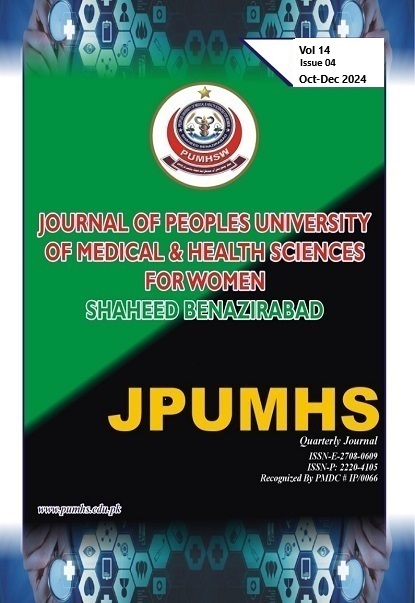MORTALITY OUTCOMES IN HEPATORENAL SYNDROME: AN ANALYSIS OF RISK FACTORS AND PREDICTIVE SCORES AT TERTIARY CARE HOSPITAL.
PUMHS;2024:14:04,206-216. http://doi.org/10.46536/jpumhs/2024/14.04.580
Keywords:
Hepatorenal syndrome, mortality, MELD score, Child-Pugh score, risk factors, liver disease, prognostic markers.Abstract
BACKGROUND: Hepatorenal syndrome HRS is one of the severe complications of end
stage liver disease with an overall prognosis for poor functional renal failure. Despite
significant advances in diagnosis and management, the mortality rate has remained
surprisingly high. Many factors, such as systemic inflammation, infections, and comorbid
conditions, further worsen the disease process. In risk stratification, scoring systems such as
MELD and Child-Pugh scores help predict this. OBJECTIVES: This study aims to assess
mortality outcomes in patients with HRS, determine associated risk factors, and examine the
utility of predictive scores for prognostication. MATERIAL AND METHODS: A cross
sectional survey of 387 patients admitted with HRS in a tertiary care institution was
conducted. Demographic data, clinical presentation, biochemical parameters, and prognostic
scores MELD and Child- Pugh were obtained. Substratification was done according to the
HRS subtypes HRS-1 and HRS-2, and on severity scores. Mortality outcomes are subjected
to regional and international studies analyses. RESULTS: Of 387 patients, 56.84% had HRS
1 and 36.17% had HRS-2. The overall mortality rate was 54.78%. Higher mortality was
associated with advanced age, HRS-1, elevated MELD scores >19, and comorbidities such as
diabetes and infections. Patients with MELD >19 had a 48.32% mortality rate. Child-Pugh
Class C showed the highest mortality at 37.98%. Female patients exhibited slightly higher
mortality rates than males at 56.68% and 53.47%, respectively. CONCLUSION: Mortality
among HRS patients remains a fatal complication of liver disease, with comorbidities and
severity of the clinical manifestation influencing mortality. MELD and Child-Pugh scores are
essentially useful tools in risk assessment. Early intervention to prioritize transplantation is
also significant for better outcomes.
Downloads
Downloads
Published
How to Cite
Issue
Section
License

This work is licensed under a Creative Commons Attribution-NoDerivatives 4.0 International License.




